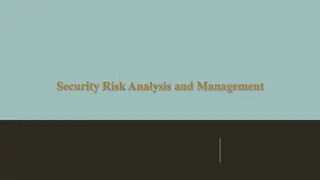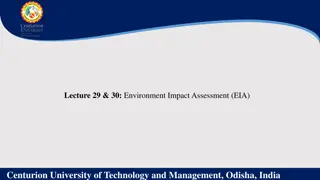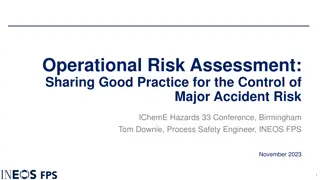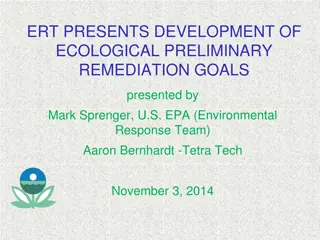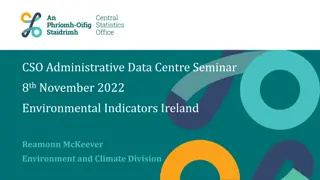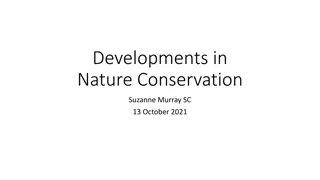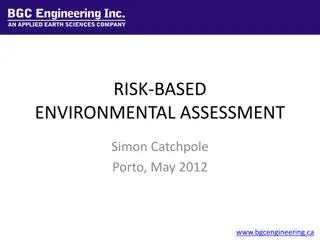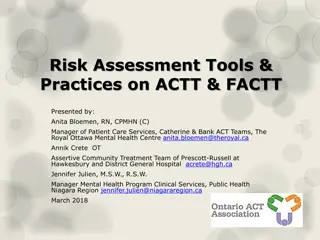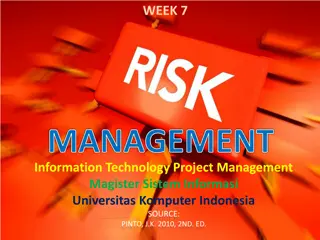
Ecological Risk Assessment in Environmental Decision-Making
Ecological Risk Assessment (ERA) plays a crucial role in environmental toxicology by estimating the risks associated with human activities on the environment. The ultimate goal of ERA is to aid risk managers in making informed decisions regarding new products, pesticides, effluents, and more. The process involves transforming scientific data into valuable insights for assessing potential ecological impacts. ERA frameworks include problem formulation, analysis, and risk characterization. Effective communication and collaboration among assessors, managers, and stakeholders are vital for successful ERA outcomes.
Download Presentation

Please find below an Image/Link to download the presentation.
The content on the website is provided AS IS for your information and personal use only. It may not be sold, licensed, or shared on other websites without obtaining consent from the author. If you encounter any issues during the download, it is possible that the publisher has removed the file from their server.
You are allowed to download the files provided on this website for personal or commercial use, subject to the condition that they are used lawfully. All files are the property of their respective owners.
The content on the website is provided AS IS for your information and personal use only. It may not be sold, licensed, or shared on other websites without obtaining consent from the author.
E N D
Presentation Transcript
Introduction Eventual goal of much environmental toxicology is ecological risk assessment (ERA) Developed as a management tool to aid in making environmental decisions (area of much uncertainty) Estimates risk of producing new product, releasing a pesticide or effluent into the environment, etc. May not be scientific assessment endpoints often set by societal perceptions and values
Purpose of ERA EPA/630/R-95/002F April 1998 April 1998 EPA/630/R-95/002F Purpose is to enable risk managers to make informed environmental decisions. Guidelines for Guidelines for Ecological Risk Assessment Ecological Risk Assessment Conducted to transform scientific data into meaningful information about the risk of human activities to the environment. (Published on May 14, 1998, Federal Register 63(93):26846-26924) 63(93):26846-26924) (Published on May 14, 1998, Federal Register Risk Assessment Forum U.S. Environmental Protection Agency Washington, DC Washington, DC Risk Assessment Forum U.S. Environmental Protection Agency Note: full text of above contained in Appendix B (p. 419 -463)
Framework for Environmental Risk Assessment Environmental risks in the sea -Previously risk assessment seen only as hazard assessment and fate -But above not easily separated in ecological systems when release chemical starts to change ecosystem while ecosystem is changing chemical - Need to go beyond and predict probability of ecological effects of chemical or action
Interaction among risk assessors, risk managers, and interested parties all phases of an ERA is critical to ensure that the results can be used to support a management decision. Because of the diverse expertise required (especially in complex ecological risk assessments), risk assessors and risk managers frequently work in multidisciplinary teams.
Schematic of Framework ERA includes three primary phases: 1. Problem formulation 2. Analysis 3. Risk characterization
Outline of Phases of an ERA 1. Problem formulation Beginning of dialogue between risk managers and risk assessors. Selection of assessment endpoints (what is important?) Risk assessors evaluate goals Prepare the conceptual model Develop an analysis plan. 2. Analysis phase Assessors evaluate exposure to stressors and the relationship between stressor levels and ecological effects. 3. Risk characterization, assessors estimate risk through integration of exposure and stressor-response profiles, describe risk by discussing lines of evidence and determining ecological adversity, and prepare a report.
Problem formulation Start of iterative process of defining the question under consideration Directly affects the scientific validity and policy-making usefulness of the ERA Composed of several six subunits
1. Discussion between risk assessor and risk manager Sets boundaries created by societal goals and scientific reality (data) Consolidates ambiguous goals Protection of endangered species Protection of fishery Preserve structure and function of ecosystem
2. Stressor characteristics? Can be biological, physical, chemical Characterized by intensity (conc. or dose) duration frequency timing scale Spatial aspect Temporal aspects
3. Ecosystems Potentially at Risk? Difficult to address transport often difficult to predict Need to look at Abiotic-biotic factors History Size Geographic relationships
4. Ecological Effects? Includes any impact upon any level of ecosystem Derived from hazard assessment (acute/chronic toxiciy) and consideration of: Biotransformations Biodegradation Reproductive effects Predator-prey interactions Production Community biomass Anything which has a direct role in the functioning of the ecosystem
5. Endpoint selection Most critical aspect of problem formulation sets stage for remainder of process Two types of endpoints Assessment endpoints Set by ecological relevance, policy goals/societal values (i.e. protect ecosystem structure/function) Often can only infer from measurement endpoints Measurement endpoints Measurable factors that respond to stressors and describe characteristics of ecosystem important to assessment endpoints Design and selection based on relevance, practicality, etc
6. Conceptual Model Framework into which data are placed Defines how data will be interpreted (what is likely to be affected: Migratory birds? Temporary pond amphibians? Etc Note: all above subject to revision based on collected information from data acquisition, verification, monitoring (DVM)

